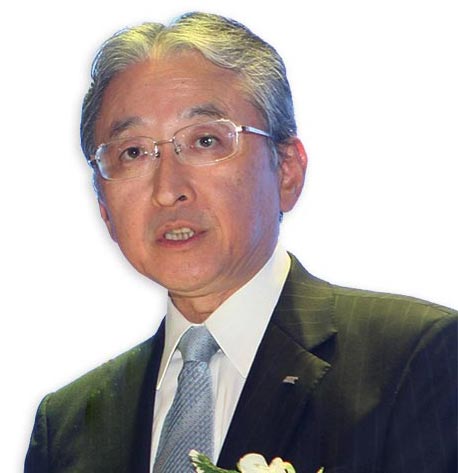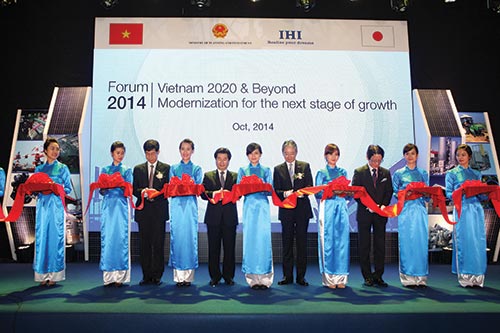Turning dreams into a reality
 During his October 2014 visit to Vietnam to further explore business and investment opportunities for Japan’s IHI Corporation, president and CEO Tamotsu Saito said he saw great potential for greater IHI involvement in Vietnam.
During his October 2014 visit to Vietnam to further explore business and investment opportunities for Japan’s IHI Corporation, president and CEO Tamotsu Saito said he saw great potential for greater IHI involvement in Vietnam.
“IHI has a proud history of over 160 years dedicated to innovation and development. And now we are working to help Vietnam realise its industrialisation dream,” he said.
“Our broad emerging market experience has led IHI to develop a deep analysis of Vietnam’s development. We have made a contribution to the country’s infrastructure development based on the experiences gained from world-class quality infrastructure projects around the world, but our dreams haven’t just ended there,” he continued.
An important market
Saito said that IHI considered Vietnam a very important market, and IHI had planned a long-term strategy for the country.
IHI has focused on four key areas in Vietnam in which it delivers tailored solutions, including infrastructure, industrial systems and general-purpose machinery, aero engines and space development, and resources, energy and the environment.
Under IHI’s Vietnam business strategy, the corporation will work towards establishing a sustainable business system for future growth of the country and a knowledge infrastructure that will boost Vietnam’s global competitiveness.
To optimise its bridge construction business, IHI is manufacturing steel structures here in Vietnam. IHI Infrastructure Asia (IIA) started operations in 2008 as a wholly IHI Corporation subsidiary. The corporation is now building a new $34 million factory to make steel structures in the northern port city of Haiphong’s Dinh Vu Industrial Zone. This factory will start operating from early 2015.
The corporation has also participated in some Vietnamese infrastructure projects using loans sourced from Japanese official development assistance (ODA) such as the construction of Nhat Tan and Binh bridges and the upgrade of the Hanoi-Ho Chi Minh City railway system, Vietnam’s CY2013 fire engine pump and the Dai Ninh hydropower project’s gate and penstock.
“We are seeking to expand further our core businesses - resources, energy and environment, social infrastructure and offshore facilities, industrial system and general-purpose machinery, and aero engine, space and defence in Vietnam. As such, we are open to opportunities of partnering and building more businesses and facilities in Vietnam,” Saito said.
Additionally, IHI also has two more companies in Vietnam including ICS Vietnam which applies vacuum heat treatment to metal parts and vacuum brazing, and IEMV Limited which builds vessels in Haiphong.
IHI is also looking forward to expanding aircraft engine and space-related product construction and is eyeing other business areas in Vietnam.
Although accounting for 60-70 per cent of the jet-engine market share in Japan, the corporation is currently only involved in the maintenance of V2500 and CF34 engines for some Vietnamese airlines.
“We aim to expand our market in aero and space-related businesses in Vietnam,” Saito stressed.

Leading Japanese heavy industry pioneer IHI has a wealth of experience
that it would like to apply in Vietnam’s modernisation efforts
Fuelling Vietnam’s modernisation efforts
As part of its deep understanding and commitment to Vietnam, in October 2014, IHI co-hosted a unique forum in Hanoi with the Ministry of Planning and Investment’s Foreign Investment Agency (FIA) to discuss modernisation solutions for Vietnam’s growth.
The event was the first-ever forum held by a private Japanese corporation and the Vietnamese government to discuss the country’s growth solutions through key pillars including energy and resources, infrastructure, industrial machinery, aero engines and space development.
At the forum, IHI introduced new technologies to hydropower plants, ports and landmark bridges in Vietnam as a trusted contractor of Japanese official development assistance projects over decades.
“The corporation’s expansion strategy also works towards establishing a sustainable business system for the country’s future growth and knowledge infrastructure that will boost Vietnam to global competitiveness,” Saito said.
The forum was aimed to set a foundation for further, deeper and more regular discussions between Vietnam government and businesses. It saw the participation of over 200 government officials, state-owned and private companies.
“We understand Vietnam’s aim to develop smartly, at the right pace. We understand the need for technological expertise that supports Vietnam’s ambition to enable exchange and business. Most importantly, we aim to empower Vietnam’s key asset and its biggest strength to drive development: the Vietnamese people and their dreams for a bright future,” Saito said. “The more we build, the more we create world-class capabilities amongst Vietnamese companies and Vietnamese talent. IHI’s primary goal is to partner with Vietnam in a way that brings benefit to the Vietnamese people.”
FIA’s general director Do Nhat Hoang highly appreciated IHI’s contributions to Vietnam.
“IHI’s decision in expanding business in Vietnam affirms the attractiveness of the country. Its initiative in co-hosting the forum has also shown the increasingly effective investment policy of Vietnam in general and Japanese active investment in particular,” Hoang said.
“For example, Nhat Tan Bridge in Hanoi is amongst the landmark projects that IHI has been building in Vietnam, along with its three other projects in Haiphong and the northern province of Hai Duong with the total investment of nearly $100 million, play a key role in the eco-socio development of Vietnam,” he continued.
With its unique approach and potential, the forum was highly appreciated by the Vietnamese government representatives, state-owned and private businesses.
IHI also signed an agreement with the Hanoi University of Science and Technology, offering full scholarships to 10 excellent students for three consecutive years at the forum.
Established in Tokyo in 1853, IHI currently operates a global network of 259 consolidated companies worldwide employing 27,500 people. Its consolidated revenues for the 2013 fiscal year (ending March 31) totalled 1.304 trillion yen ($11 billion) with landmark projects seen across regions from the home-market of Japan to the Americas, China, Southeast Asia and Europe, the Middle East and Africa.
What the stars mean:
★ Poor ★ ★ Promising ★★★ Good ★★★★ Very good ★★★★★ Exceptional
Latest News
More News
- Lawmakers split over VAT on fertilisers and animal feed (December 10, 2025 | 18:56)
- Kim Long deal marks turning point for Vietnam’s auto industry (December 10, 2025 | 18:44)
- Pernod Ricard Vietnam supports flood-hit localities (December 10, 2025 | 14:18)
- SABECO honoured at Vietnam M&A Forum for outstanding deal of 2024-2025 (December 10, 2025 | 12:00)
- Vietnam raises taxable revenue threshold for household businesses to VND500 million (December 10, 2025 | 11:34)
- Vietnam M&A Forum 2025: new position, new momentum (December 09, 2025 | 14:30)
- Masan Consumer reveals HSX listing roadmap (December 09, 2025 | 14:09)
- Industrial sector posts robust gains as year-end demand rises (December 09, 2025 | 13:38)
- Foreign fruits flood Vietnamese market (December 09, 2025 | 13:22)
- Phu Tai Group and FPT accelerate digital governance with SAP cloud ERP (December 09, 2025 | 12:41)
















 Mobile Version
Mobile Version